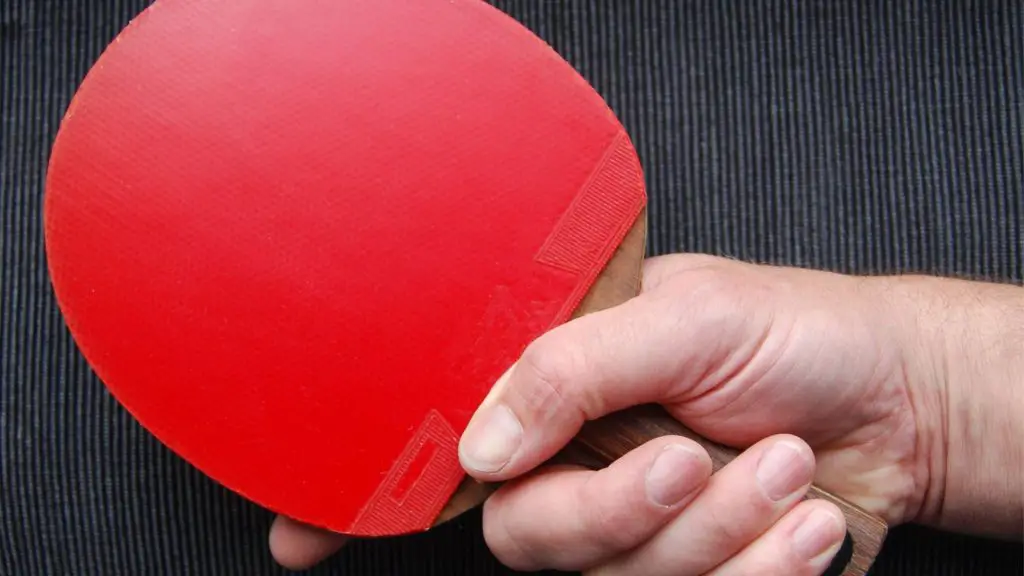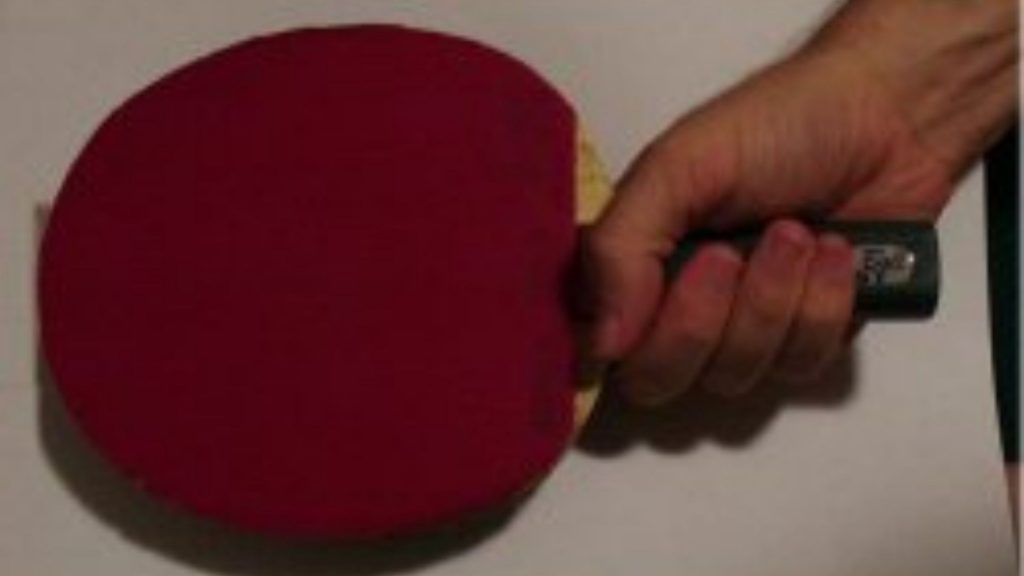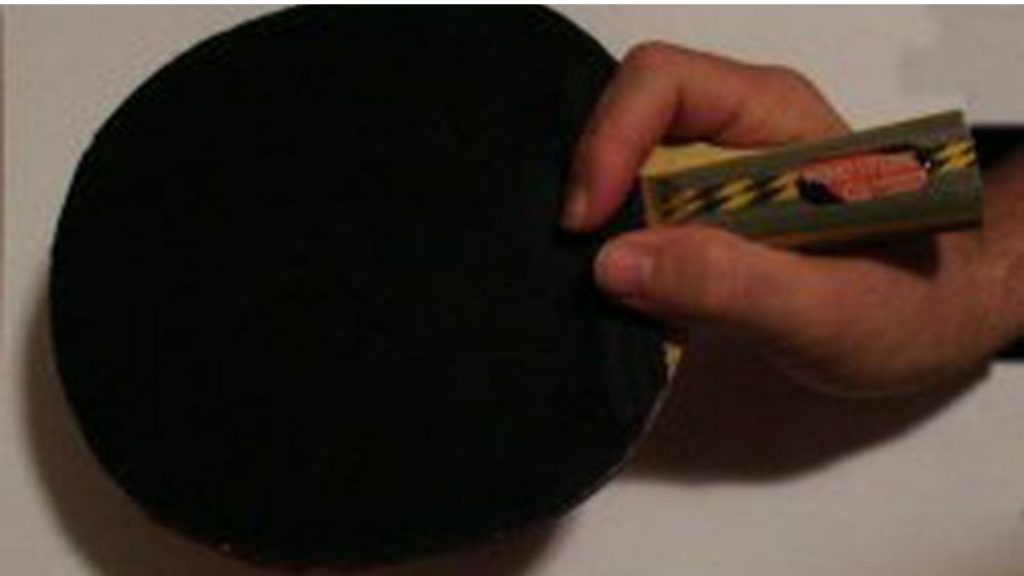If you are here to learn about how to hold a ping pong paddle then you are in the right spot. It depends on your grip, but the most common way is to hold the paddle with one of your hands and wrap your fingers around it. So that they’re on the side of the blade facing you.
From there, you should place your index finger and thumb on either side of the ball near where it meets the paddle. You can use both hands if you want, but this is a more advanced grip that not everyone is able to do.
If you want the most flexibility and control, you will need to learn how to hold a ping pong paddle using both hands. With this grip, your index finger should be placed on one side of the ball and your middle finger on the other side of it near where it meets the paddle.
Your thumb should sit behind that point and wrap around the paddle, perpendicular to your index finger. This grip gives you a little bit less control over the ball but allows you to hit it from different angles.
Once you feel comfortable with these grips and understand how they work. Ping pong will become much more fun for you! If you would like more guidance on how to use either of these grips, you should get in touch with a local instructor or ping pong professional.
Why it’s important to choose the right grip
Since ping pong is a game that requires both hands, it’s important to pick the right grip the hold your paddle.
Different grips can provide different advantages. For example, if you want to be able to spin the ball more easily, using a Continental grip is better than using an Eastern grip. A lot of people use an Eastern grip because it’s easier to do but this is not always the best option for spinning the ball. It also doesn’t help if you want to serve with spin.
If you’re not sure which grip to use, it’s best to try both and see which one feels more comfortable. If you still don’t know which way to lean after that. Then for right-handed players, use a pen or anything straight as a mock paddle and extend your arm out in front of you.
Holding your hand palm down with the fingers towards you (the back of your hand facing away from you), use the straight object to point at your target. Then, turn your wrist out until it’s vertical and pointing up. You’ll notice that this is where using an Eastern grip feels natural.
How to hold a ping pong paddle – different ways to hold the paddle
The Shakehand Grip

The Shakehand Grip is a type of grip that can be used for either the forehand or backhand shots. A player places one of their hands on top and inside their racquet and reaches across their body with the other hand from below.
Players use this grip when they are looking to play a flat, high ball out wide. It is most commonly used by players with long, slender fingers who want to create as much topspin as possible on their forehand or backhand shots.
The Shakehand Grip is the most popular choice among Asian players, particularly in China and Japan. This grip has helped many Chinese players achieve success in international tournaments. Such as the Olympics and World Championships.
So, this grip came into play when Ichiro Ogimura started to win games on the court. And in the 1950s and 1960s, there were only a few well-known players who used it.
The Shallow Shakehand

The Shallow Shakehand is a variation of the Shakehand grip. In which the player’s hand is held with a less vertical extension so that it sits closer to the racquet. The “shallow” in the grip’s name refers to the depth of the player’s palm below their wrist when they grip their racquet.
While many players are perfectly comfortable with the deep fist-shake grip, there are some who find it to be uncomfortable. This is due to many factors including wrist mobility issues.
Apart from that, the positioning of the racquet face in relation to their forearm upon impact. The shallow grip can allow for more comfort because it does not require as much vertical extension.
A shallow grip is a great option for players who have issues with wrist pain or discomfort in the deep Shakehand when hitting from close to the table.
It does not provide as much power as the fist-shake, but it can add spin and precision to one’s game. The grip also has some similarities to Penhold and is useful for those who play this grip as well.
The shallow grip can be a little tricky to use at first, but it becomes much easier after a few weeks of practice. It requires a good amount of wrist movement to generate power and spin, which can take time to get used to.
The Deep Shakehand
The Deep Shakehand is a variation of the Shakehand handshake that was introduced by S. Anderson and P. Parkinson in 1988.
This handshake typically starts off with one person extending their hand to shake, palm up. The other person then reaches over and grasps the wrist of the first person with the fingers of their hand, palm facing outward.
The first person then rotates outwards to make contact with the back of the second person’s hand, using the fingers of their hands for stability and not forcefully grabbing onto each other’s hands too tightly (Drummond, 2008).
Once this rotation is made, the second person then grasps the fingers of the first person. This handshake is typically used with stiffer rackets, which are more effective when paired with this type of grip. The depth of the grip generally depends on how deep one would prefer to shake hands.
The Penhold grip
The Penhold grip is a style of playing in table tennis that is relatively rare among casual or competitive players. However, it does provide an additional option for playing the game with the hand in a more natural position. There are two variants of the Penhold grip, Eastern and Western.
The Eastern style is more traditionally accepted by players with East Asian heritage. While the Western variant is commonly used by players with a European heritage.
However, the two styles are interchangeable and can be used effectively by players of any ethnicity.
The Eastern variant of the Penhold grip is held with a hand that has four fingers on the rounded side of the handle. And one finger flattening against the table from above it. This style provides greater control over brush strokes but requires more skill to master.
The Western variant of the Penhold grip is held with four fingers on the flat side of the handle and one finger flattening against the table from above it. This style provides greater control over pushes but requires more skill to master.
It is not as commonly used by casual players because it does not provide an advantage for any stroke that is commonly utilized during a casual game.
The most effective way to perform strokes with the Penhold grip depends on player preference and comfortability. It can vary based on the version of the grip that is used by the individual player. Thus, rather than providing a comprehensive list of all possible strokes, only some common examples are provided below:
However, the most important thing to remember with the Penhold grip is that it requires additional practice to master more complicated strokes. Because of this, it may be a good idea for new players who wish to try out different styles of play to start with the Shakehand grip instead.
The Chinese Penhold
The Chinese Penhold is a type of grip used in fast and slow versions of table tennis. The Penhold generally grips the bat in the webbing between the thumb and fingers. Besides that, it allows players to be more effective at cutting balls on one side of their body.
In general, penholders have a disadvantage against players who use a Shakehand grip. Because they are not as good at hitting topspin shots on both sides of their bodies. Yet, players with a Penhold can make up for this by blocking backspin more efficiently because they can rotate their wrists more.
The Japanese or Korean Penhold
The Japanese Penhold is used by both men and women. It has a larger blade than the Chinese one. The Korean Penhold is similar to the Japanese Penhold but it has an extra, smaller blade.
The Japanese Penhold has a grip that is more cylindrical and larger than the Chinese Penhold. This makes it easier for players to hold but less maneuverable. In contrast, the Korean Penhold is shorter and as a result, more maneuverable.
Reverse Backhand Penhold

A reverse backhand Penhold is a type of grip on the badminton racket with the player’s palm facing away from his body, towards the net.
It is usually used by players who are right-handed, but left-handed players can use it as well. The reverse backhand is also sometimes called the “Penhold backhand” or “reverse side-hand.”
A reverse backhand is more difficult than the standard backhand because of the physical challenge of hitting over one’s head.
For some players, this difficulty can be offset by their height advantage. A tall player with a long racket may find it easier to execute a reverse backhand than someone shorter with a medium or short racket.
Depending on the type of racket, a normal backhand can be dangerous for right-handed players to use against shots such as cross shots and body shots.
Those shots come across the net so fast that they can hit an incoming player in the hand or arm. A reverse backhand helps protect right-handed players from these types of shots.
After learning these grips beginners need the best ping pong paddle for beginners.
Frequently Asked Questions
How do the Chinese hold a ping pong paddle?
The Chinese typically hold a ping pong paddle with one hand in a vertical position and the other hand in a horizontal position.
How do you hit a spin shot in ping pong?
A spin shot is a pretty simple motion that you can learn in a few minutes and can be used in a number of ways.
The first way is to simply put the ball on the table instead of using your hand like you would for a smash. It’s also called an “inverted reverse” or “inverted topspin”.
The ball will go high and come back down with topspin. You can use this with quick or slow spinning balls and it’s typically used as a return shot.
Second, you can use it as an offensive shot where you hit the ball and then quickly move it off the table. This is called a “clear”. You hit the same direction as if you were going to play a topspin shot, but you don’t let the ball bounce.
Third, you can use it as a tricky return where you put a spin on the ball and make it shoot off the other way to throw your opponent off. This is called a “perceived spin” or a “reverse-kick”.
Even if your opponent sees that you’re about to put a spin on the ball, it will still sometimes go off in the direction you want.
Fourth, you can use the backspin motion of putting your paddle under the ball and lifting it up (while getting ready for topspin) to make the ball jump straight up. This is called a “jump shot”. You hit slightly behind the ball and you use your wrist to make it jump off.
Finally, if you combine all of them together with fast or slow spin, you can make better shots.
How do you hit a backhand in ping pong?
A backhand is a shot in which the player reaches across the body with the arm on the opposite side of the ball, typically using that arm to strike it.
A typical example of an important point at which backhands are widely used is in singles matches. When there are no good shots available on either side or when players are too far apart for a forehand.
How does Ma Lin hold his paddle?
This question is difficult to answer because different people have different opinions on this. Some people say that his paddle is in front of him or near his stomach while others say it’s behind him.
It seems he doesn’t hold the paddle in the same way at all times because you can see him moving it around during a match.
First of all, I think his paddle position changes depending on the shot he is about to play. Ma Lin likes to chop far from the table, so it seems that when he wants to chop, his paddle is closer to him. This makes sense because you would need more strength if you want to chop a ball that’s away from the table.
On the other hand, Ma Lin chooses to attack high balls with a fast attacking shot rather than defending them. When he wants to do this, his paddle is out in front of him.
This is because you need more speed when doing an attacking move on a ball that’s near the table instead of far away from it.
Ma Lin isn’t aggressive all the time, so it seems that when he wants to play defensive, his paddle is behind him. He usually does this backhand if he’s at the table and not further away from it.
This makes sense because you would need less strength if you want to return a ball that’s much closer to you.
How do Asians hold a ping pong paddle?
Most often, the way that individuals in Asia hold a ping-pong paddle is to hold it close to the body with their arm bent at the elbow. This allows for maximal control of where they hit the ball. They also typically use both hands for this type of grip.
It is noticeable that most players in Asia use both hands on the paddle when playing ping-pong. The grip is most often held close to their body, which provides more control over how they place their shot. Another commonality among players in Asia is that they typically hit the ball with a straight arm.
Final Thoughts
Hold the paddle in your dominant hand, with one finger on top and three fingers below. Keep a tight grip as you hold it overhand then take a step back from the table to serve or receive balls. When you’re ready to hit the ball, hold your arm up at a 90-degree angle and snap it back for a forehand shot.
If you prefer a backhand approach, keep your upper body turned slightly more towards the side of the table where the ball is coming from. And turn your wrist so that when you hit the ball it bounces off the back of the paddle.
I hope from our detailed analysis about different holding grips, you have learned how to hold a ping pong paddle correctly. Before using them in the match practice them carefully.

Hi, My name is Benjamin Fink and I am the author of the ping pong reviewed blog. I am a sports person learning and sharing my knowledge with others about ping pong and other sports.
I have been playing ping pong for the last 17 years and teaching people about the game and writing new things about the game through this blog When finding something new. I have participated in serious ping pong tournaments in my country.

